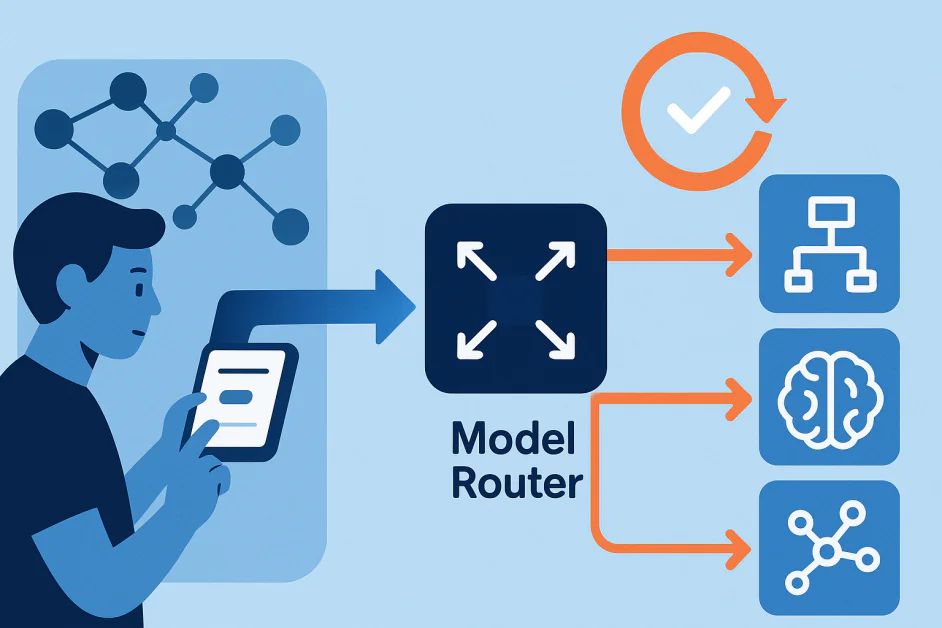Künstliche Intelligenz
Model Routers and the Feedback Trap: How AI Learns from Itself

Modern AI systems are no longer built around a single model that handles every task. Instead, they rely on collections of models, each designed for specific purposes. At the center of this setup is the model router, a component that interprets a user’s request and decides which model should handle it. For example, in systems like GPA-5 von OpenAI, a router might send a simple query to a lightweight model for speed while routing complex reasoning tasks to a more advanced model.
Routers are not just traffic managers. They learn from user behavior, such as when people switch models or prefer certain answers. This creates a cycle: the router assigns the query, the model produces an answer, user reactions provide feedback, and the router updates its decisions. When these cycles operate quietly in the background, they can form hidden feedback loops. Such loops may amplify bias, reinforce flawed patterns, or gradually reduce performance in ways that are difficult to detect.
This article looks at how model routers work, how feedback loops emerge, and what risks they pose as AI systems continue to evolve.
Understanding Model Routers in AI
A model router is the decision-making layer in a multi-model AI system. Its role is to determine which model best fits a task. The choice depends on factors such as query complexity, user intent, context, and trade-offs between cost, accuracy, and speed.
Unlike systems that follow fixed rules, most model routers are machine learning systems themselves. They are trained on real-world signals and adapt over time. They may learn from user behavior such as switching between models, rating answers, or rephrasing prompts as well as from automated evaluations that measure output quality.
This adaptability makes routers powerful but also risky. They enhance efficiency and provide a better user experience, but the same feedback processes that refine their decisions can also create reinforcing loops. Over time, these loops can affect not only routing strategies but also how the larger AI system behaves.
How Feedback Loops Take Shape
A Rückkopplungsschleife occurs when a system’s output influences the data it later learns from. A simple example is a recommender system: if you click on a sports video, the system shows you more sports content, which shapes what you watch next. Over time, the system reinforces its own patterns. Another example to understand the feedback loop is predictive policing. An algorithm may forecast higher crime in certain neighborhoods which could lead to more patrols. Increased patrols uncover more incidents, which then confirm the algorithm’s prediction. The system looks accurate, but the data is skewed by its own influence. Feedback loops can be direct or hidden. Direct loops are easy to recognize, such as a recommender retraining on its own suggestions. Hidden loops are more subtle because they arise when different parts of a system indirectly influence each other.
Model routers can create similar loops. A router’s decision shapes which model produces the answer. That answer shapes user behavior, which becomes feedback for the router. Over time, the router may start reinforcing patterns that worked in the past rather than consistently choosing the best model. These loops are difficult to detect and can quietly push AI systems in unintended directions.
Why Feedback Loops in Routers Are Risky
While feedback loops help routers improve at task matching, they also carry risks that can distort system behavior. One risk is reinforcing initial biases. If a router repeatedly sends a certain type of query to Model A, most of the feedback will come from Model A’s outputs. The router may then assume Model A is always best, sidelining Model B, even if it could sometimes perform better. This unequal usage can become self-reinforcing. Models that perform well on routed tasks attract more requests, which reinforce their strengths. Underused models receive fewer chances to improve, creating imbalance and reducing diversity.
The biases can also come from the evaluation models used to judge correctness. If the “judge” model has blind spots, its biases are passed directly to the router, which then optimizes for the judge’s values rather than actual user needs. User behavior adds another level of complexity. If a router tends to return certain styles of answers, users may adapt their queries to match those patterns, reinforcing them even more. Over time, this can narrow both user behavior and system responses. Routers may also learn to associate certain query patterns or demographics with specific models. This can lead to systematically different experiences across groups, potentially reinforcing and amplifying existing societal biases.
Another key concern is long-term drift. The decisions a router makes today influence the training data used tomorrow. If models are retrained on outputs influenced by routing, they may learn the router’s preferences rather than independent approaches. This can make responses across models more uniform and embed biases that persist over time.
Strategies to Break the Cycle
Reducing the risks of hidden loops requires active design and oversight. Training should use diverse data sources, not just user clicks or switches. Occasional random routing can also prevent one model from monopolizing a task type. Monitoring is essential. Regular audits can reveal whether a router is drifting toward certain patterns or over-relying on a single model. Transparency in router decisions helps researchers detect bias early.
Routers should also be retrained periodically with fresh, balanced data so old biases do not become locked in. Incorporating human oversight, especially in sensitive domains, adds another layer of accountability. Humans can identify when a router systematically favors one model or misclassifies certain queries.
The key is to treat the router as a model subject to feedback, not as a fixed or neutral component. By recognizing how routers themselves are shaped by the data they create, researchers and developers can design systems that remain fair, adaptive, and reliable over time.
Fazit
Model routers offer clear benefits in efficiency and adaptability, but they also carry hidden risks. Feedback loops within these systems can quietly amplify bias, limit diversity of responses, and lock models into narrow patterns of behavior. As these architectures become more common, recognizing and addressing these risks early will be key to building AI systems that remain fair, reliable, and genuinely adaptive.












